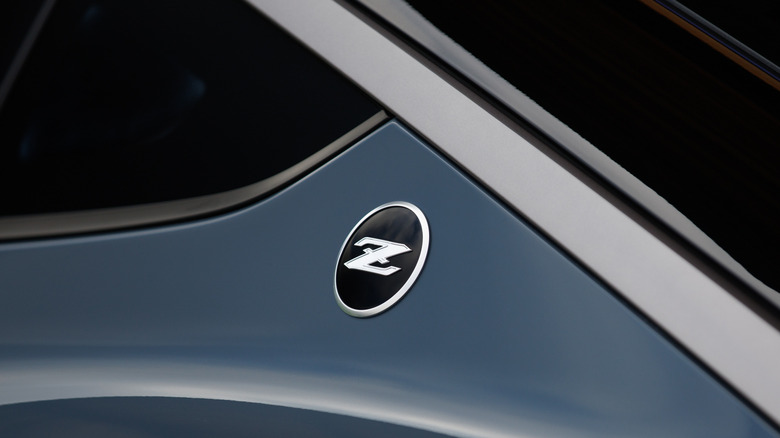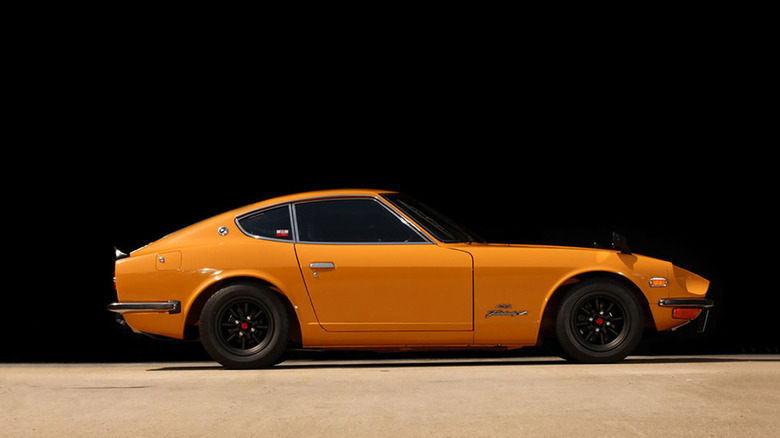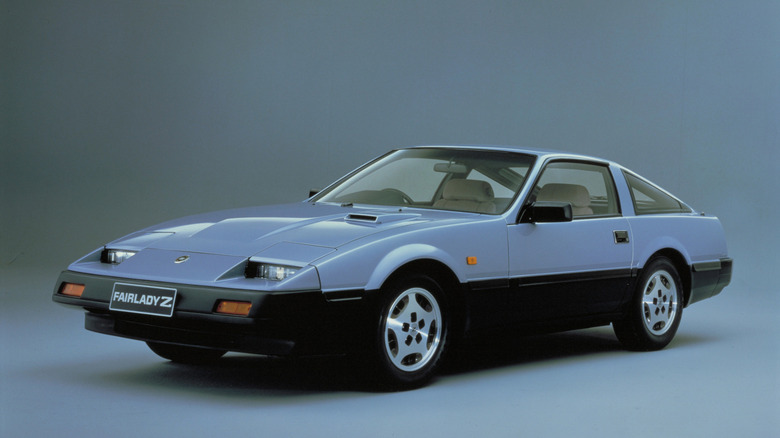Does The 'Z' Stand For Or Mean Anything On Nissan Cars?
Generally speaking, Nissan's various cars sport surprisingly poetic names. From the sporty, metropolitan, and contemporary emotions behind the Skyline to even the more pedestrian models like the Stanza and later Altima — all of these names have various meanings behind them. Which leaves one major vehicle in their dealership somewhat anomalous: the Nissan Z.
The Nissan Z is the common name for the various generations of the company's premiere two-seater or 2+2 sports coupe. First introduced in 1969 as the Japan-exclusive Nissan Fairlady Z, this vehicle introduced the affordable, upscale, mass-produced sports car to the Japanese market. Whereas the Toyota 2000GT was Japan's Ferrari, the Z-car was its Mustang. And much like other vehicles in Nissan's lineup, the Fairlady Z's name didn't come about by accident.
Then-president of Nissan Corporation U.S.A. Yukata Katayama, or simply "Mr. K," was known internally as the "Father of the Z." He originally coined the "Z" name as well as its "240Z" counterpart destined abroad for Datsun dealerships, though wasn't responsible for the "Fairlady" badge — that honor goes to Nissan's domestic president Katsuji Kawamada. As for the "Z" badge, the car bears this letter because, as Nissan puts it, the Nissan Z represents "the last word" in sports cars — so Mr. K chose the final letter of the alphabet as a signifier of this quality. And virtually every Z-car that left Nissan's factory to this day retains this unique name, generally with a series of other numbers and letters attached. Let's dive in further and discuss the car's history and decode what the rest of its name means.
Origins of the Z
The concept of a Western-style JDM sports car originated well before the time of the Fairlady Z. In fact, many of Japan's postwar designs featured heavy influences from American and European sensibilities at the time. Several influential figures pushed for export in these markets, among them being Nissan, which opened its first American dealership in 1959. President Yukata Katayama headed this division and proposed the concept of a Western-influenced mass-produced sports car. Fighting through bureaucracy and stubbornness, the fastback design finally receives the stamp of approval and production begins in 1969.
The name on the Japanese cars is actually a marriage between two disparate perspectives. First, you have Mr. K's input on the "Z" nomenclature, then you have the "Fairlady" prefix. Katsuji Kawamada happened to be in the United States during the Z's developmental stages and caught the Broadway show "My Fair Lady" in 1961. The show itself enjoyed a healthy, long run, and so Kawamada's belief was that the popularity might carry over to the "Fairlady" car as well.
But the cars received one noticeable alteration when they arrived stateside: a name change. The badge went from "Nissan" to "Datsun," and the "Fairlady" badge was replaced with one that read, "240Z." Legend even has it that Mr. K himself ordered the badges to be ripped off the tailgates of each and every imported vehicle to be replaced with the "240Z" nameplate. Regardless, the car was an immediate hit and remained popular throughout its storied life, proving itself as a true enthusiast's machine and one of the most important sports cars ever created.
The various iterations of the Z-car
Naturally, as time went on, the "Z" name stuck around, but the platforms wearing them changed substantially. In total, the Nissan Z-car witnessed seven distinct generations between 1969 and the present-day, with each one of them boasting a different combination of letters and numbers. So in the same lineup you have the Fairlady Z, the Datsun 240Z, Nissan 300ZX, the other Nissan 300ZX, 350Z, and many more– right up to the current model, simply known as "Nissan Z" or "Nissan 400Z."
In all cases, the Z-car derives the number from the engine's displacement – for instance, the 240Z uses a 2.4L engine, the 350Z's VQ35DE is a 3.5L V6, and so on. As for the "X" suffix at the end of some models, that's a bit more muddled and complicated. First introduced in 1978, the Datsun 280ZX was essentially a larger, more luxury-oriented Nissan Z-car. The car was criticized at the time for its poor, ungainly handling characteristics, a distinct departure from the tight, smooth handling of its predecessor. Regardless, the "X" name then essentially became colloquially associated with "luxury" and was marketed as such by Nissan, which simply carried over the suffix to the next-generation model in 1983.
Sometimes you might hear the various Z-cars referred to as "S30," or "Z31," and so on — these represent the internal model codes Nissan assigned to each generation. The most recent iterations are the Z34 (2009-2021) and RZ34 (2022-present), with the latest simply dropping all former naming conventions in favor of the lone "Z" badge.


